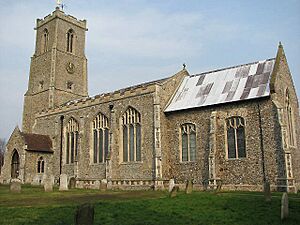Church of St Helen, Ranworth facts for kids
Quick facts for kids Church of St Helen |
|
|---|---|
 |
|
| Lua error in Module:Location_map at line 420: attempt to index field 'wikibase' (a nil value). | |
| Location | Ranworth, Norfolk |
| Country | England |
| Denomination | Church of England |
| History | |
| Founded | 14th century |
| Dedication | Saint Helen |
| Architecture | |
| Heritage designation | Grade I |
| Designated | 25 September 1962 |
| Administration | |
| Parish | Ranworth with Panxworth |
| Diocese | Diocese of Norwich |
The Church of St Helen in Ranworth, Norfolk, is a very old church. It is famous for its amazing collection of medieval paintings. People sometimes call it "the Cathedral of The Broads" because it's so grand. The church was built in the 1300s, but its history goes back even further to Saxon times. Inside, you can find many old treasures, like the beautiful Ranworth rood screen and a special old book called the Ranworth Antiphoner. This church is still used today and is a very important Grade I listed building.
Contents
A Look at the Church's Past
The Church of St Helen is often called "the Cathedral of The Broads." Experts at Historic England say it was built in the 1400s. Other sources suggest it might be even older, from the 1300s. Some of the wooden roof beams inside have the date 1370 carved on them.
The church needed a lot of repair work in the late 1800s and early 1900s. This was done to stop it from falling down completely. In 1963, a fire damaged the thatched roof over the chancel, which is the part of the church near the altar. Luckily, the rest of the church was not badly harmed.
Amazing Medieval Art
What makes St Helen's Church truly special is its beautiful medieval artwork. The most famous part is the Ranworth rood screen. This is a decorated screen that separates the nave (where people sit) from the chancel. A writer named Simon Jenkins believes these paintings are "England's finest church screen paintings."
The rood screen has painted panels showing the Twelve Apostles. These were the main followers of Jesus. There are also 26 other paintings of saints and bishops found in different parts of the church. These artworks were created in the 1470s or 1480s. They are known for their "superb quality," meaning they are very well done.
Today, St Helen's Church is still an active church. It serves the local communities of Ranworth and Panxworth.
How the Church Was Built
The Church of St Helen started being built in the 1300s. This was during a time when a style called Decorated Gothic was popular. However, much of the church shows the influence of the Perpendicular style, which became popular about a century later.
The church is made from Rubble stone. It has special Clipsham stone around the windows and doors. At the western end of the church, there is a tall, three-story tower. After the tower, you enter the nave, which is the main part of the church. There are two porches, which are covered entrances. Beyond the nave is the chancel, where the altar is located.
The Church of St Helen is a Grade I listed building. This means it is considered a very important historic building. While the inside paintings are amazing, some people think the building itself is "of limited architectural interest."
Inside the Church
Inside the church, you can also see a special field altar. This altar was used during World War I by a Reverend named Teddy Everard. He later became the vicar, or priest, of Ranworth. There is also a memorial panel inside the church. It remembers the 14 brave men from the village who lost their lives in the war.

